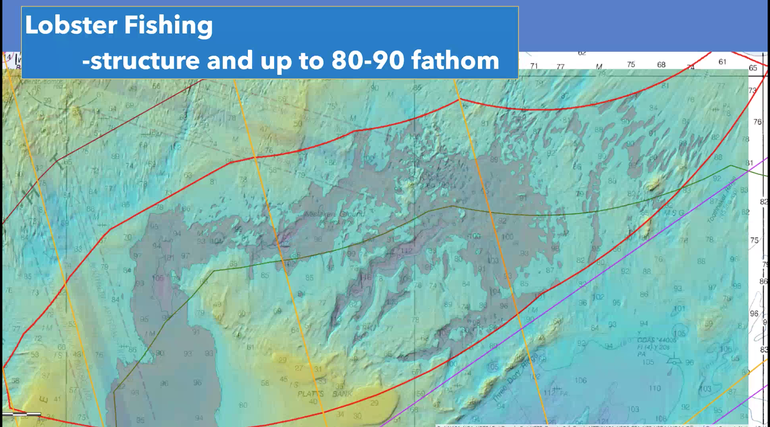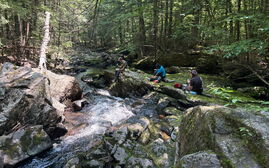Maine homes in on offshore wind site, but fishermen’s protests continue
 Courtesy / Department of Marine Resources
Seen here is an “area of interest” bounded in red for an offshore wind project. Areas in green and yellow are most used by the lobster fleet. Deeper waters depicted in gray have less lobster fishing activity.
Courtesy / Department of Marine Resources
Seen here is an “area of interest” bounded in red for an offshore wind project. Areas in green and yellow are most used by the lobster fleet. Deeper waters depicted in gray have less lobster fishing activity.
Using fishery data and interviews with fishermen, state fishery regulators are working to identify areas in federal waters off Maine’s southern coast that will have least potential conflict between the fisheries and a proposed offshore windmill site.
Fishermen attending a virtual meeting hosted Tuesday night by the Department of Marine Resources condemned a plan by offshore wind developer New England Aqua Ventus to lease up to 16 square miles in the Gulf of Maine to install up to 12 wind turbines.
In addition, fishermen and their supporters gathered this morning at the Augusta Civic Center for a “Protect the Gulf of Maine” rally to protest the pace of wind development.
In a related development, Gov. Janet Mills on Wednesday introduced legislation to establish a 10-year moratorium on new offshore wind projects in state waters, while reaffirming her administration’s priority of locating offshore wind projects in federal waters of the Gulf of Maine.
Identify fishing areas
The Department of Marine Resources is in the midst of holding regional meetings with the state’s lobster zone councils to discuss an area being reviewed in the midcoast or southern Maine region for the potential of a floating offshore wind research array in federal waters.
The department’s role in the process is to get an understanding of fishing activity in the area of interest and to share latest updates with the industry on where the siting conversation is heading.
The Governor’s Energy Office has identified an oval-shaped "area of interest" for the project, southeast of Casco Bay. To the west, the area crosses onto traditional fishing grounds called Jeffrey’s Basin and Platts Bank. Another fishing area, Mistaken Ground, is in the middle of the oval.
The oval covers about 770 square miles. Its landward side starts about 20 miles from shore and its seaward side is about 40 miles from shore.
The state is seeking input from stakeholders, including the fishing industry, on where to put the turbines within the area in order to minimize impacts to other users of the area.
So far, data and interviews reveal that lobstermen in the western half of the state tend not to use areas deeper than 90 fathoms, or 540 feet.
Electronics data gathered from devices called “vessel monitoring systems” aboard groundfishing boats revealed areas of high activity in certain areas but, like the lobster industry, less so in deeper waters.
The department is overlaying information to find sites with the least impact.
Poor tradeoff
But during last night’s virtual meeting, the sense among fishermen was that putting windmills in traditional fishing grounds was a poor tradeoff between the thriving fishing industry and an untried activity. They pointed to the traditional use of the gulf as a shared resource and objected to leasing a portion of it to a private developer.
“I am dead set against this,” said Zone B Council Chairman David Horner. Zone B is an area that covers lobster fishing grounds off Mount Desert Island.
The “area of interest” crosses the fishery’s western zones D, E and F.
John Drouin, chairman of easternmost Zone A, said that, while the project might give jobs to the wind industry, it will cost fishery jobs.
“It seems like a poor tradeoff as far as the industry that’s already using the area,” Drouin said.
The siting in western waters might seem less relevant to fishermen to the east. But Zone B Council member James Hanscom said the matter is relevant to any user of the gulf because of the potential for the wind industry to expand.
The gulf is traditionally a shared resource, said Hanscom. “Now we’re leasing off portions of our Gulf of Maine,” he said.
The department’s commissioner, Patrick Keliher, said the industry needs to remain engaged in the process.
“As far as the fishing industry has been alive and well in the state for centuries, our role is to make sure that continues,” he said.
Fishermen’s rally
The rally on Wednesday morning was organized by the Maine Lobstering Union (Local 207), with support from Maine Coast Fishermen’s Association and in partnership with the Downeast Lobstermen’s Association and Maine Lobstermen’s Association.
Maine has plans for two offshore wind turbine deployments. New England Aqua Ventus plans to construct one turbine that extends 750 feet to the top of the blade off Monhegan Island, as well as the second larger project proposed off the southern coast.
“This has alarmed Maine fishermen who worry that Maine is risking the health of one of the world’s most productive marine ecosystems that has supported our coastal economy for more than a century in its race to be the first to erect a floating wind array,” according to a news release.
The fishing industry is asking the Governor's Energy Office to complete an offshore wind “road map” before bringing large-scale projects to the Gulf of Maine.
“This is not a research array; this is a full-scale commercial project, and it is imperative that we understand how it will impact the ocean, fishing families, coastal communities, and ratepayers before any other conversations take place,” Patrice McCarron, executive director of the Maine Lobstermen’s Association, said in the release.
“We are currently operating on extraordinarily little data and we are putting one of Maine’s most iconic and important industries at risk of complete collapse.”
Mills bill
The legislation introduced by Mills on Wednesday would establish a 10-year moratorium on new offshore wind projects in state waters.
The moratorium would preserve state waters for fishing and recreation, while reaffirming Maine’s priority of locating offshore wind projects in federal waters of the Gulf of Maine, where the state has proposed the nation’s first research array for floating offshore wind technology.
The legislation was developed in response to concerns from Maine’s fishing industry, according to a news release.
Nearly 75% of Maine’s commercial lobster harvesting occurs in state waters.
“Maine is uniquely prepared to grow a strong offshore wind industry, create good-paying trades and technology jobs around the state, and reduce Maine’s crippling dependence on harmful fossil fuels,” Mills said in the release. “We will focus these efforts in federal waters farther off our coast, as we responsibly pursue a small research array that can help us establish the best way for Maine to embrace the vast economic and environmental benefits of offshore wind.
"Fundamentally, I do not believe offshore wind and Maine’s fishing industry are mutually exclusive. I believe they not only can coexist, but, together, can help us build a stronger economy with more good-paying jobs and a brighter, more sustainable future for Maine people.”
The moratorium legislation is sponsored by state Sen. Mark Lawrence, D-York, Senate chair of the Legislature’s Energy, Utilities and Technology Committee.














0 Comments